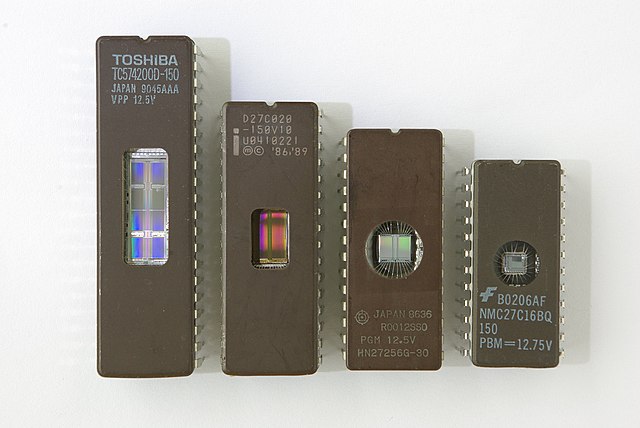In microelectronics, a dual in-line package is an electronic component package with a rectangular housing and two parallel rows of electrical connecting pins. The package may be through-hole mounted to a printed circuit board (PCB) or inserted in a socket. The dual-inline format was invented by Don Forbes, Rex Rice and Bryant Rogers at Fairchild R&D in 1964, when the restricted number of leads available on circular transistor-style packages became a limitation in the use of integrated circuits. Increasingly complex circuits required more signal and power supply leads ; eventually microprocessors and similar complex devices required more leads than could be put on a DIP package, leading to development of higher-density chip carriers. Furthermore, square and rectangular packages made it easier to route printed-circuit traces beneath the packages.
4000-series logic ICs in 0.3" wide 14-pin plastic DIP packages (DIP-14N), also known as PDIP (Plastic DIP)
EPROM ICs in 0.6" wide ceramic DIP-40, DIP-32, DIP-28, DIP-24 packages, also known as CDIP (Ceramic DIP)
Eight-contact DIP switch with 0.3" wide 16-pin (DIP-16N) footprint
An operating prototyped circuit on a solderless breadboard incorporating four DIP ICs, a DIP LED bargraph display (upper left), and a DIP 7-segment LED display (lower left)
A semiconductor package is a metal, plastic, glass, or ceramic casing containing one or more discrete semiconductor devices or integrated circuits. Individual components are fabricated on semiconductor wafers before being diced into die, tested, and packaged. The package provides a means for connecting it to the external environment, such as printed circuit board, via leads such as lands, balls, or pins; and protection against threats such as mechanical impact, chemical contamination, and light exposure. Additionally, it helps dissipate heat produced by the device, with or without the aid of a heat spreader. There are thousands of package types in use. Some are defined by international, national, or industry standards, while others are particular to an individual manufacturer.
This replica of the first laboratory transistor shows connecting leads and a glass jar for protection; packaging the device was critical to its success.
A hybrid integrated circuit
Assorted discrete through-hole components
A silicon wafer; individual devices (VLSI in squares) are not usable until diced, wire-bonded, and packaged







